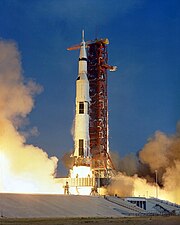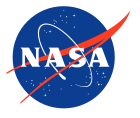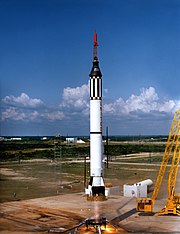NASA
From Wikipedia, the free encyclopedia
[edit] History
[edit] Space race
After the
Soviet space program's launch of the world's first artificial
satellite (
Sputnik 1) on October 4, 1957, the attention of the United States turned toward its own fledgling space efforts. The
U.S. Congress, alarmed by the perceived threat to national security and technological leadership (known as the "
Sputnik crisis"), urged immediate and swift action; President
Dwight D. Eisenhower and his advisers counseled more deliberate measures. Several months of debate produced an agreement that a new federal agency was needed to conduct all non-military activity in space. The
Advanced Research Projects Agency (ARPA) was also created at this time to develop space technology for military application.
On January 14, 1958, NACA Director
Hugh Dryden published "A National Research Program for Space Technology" stating:
[11]
| “ | It is of great urgency and importance to our country both from consideration of our prestige as a nation as well as military necessity that this challenge [Sputnik] be met by an energetic program of research and development for the conquest of space... It is accordingly proposed that the scientific research be the responsibility of a national civilian agency... NACA is capable, by rapid extension and expansion of its effort, of providing leadership in space technology.[11] | ” |

Explorer 1, first US satellite
Launched on January 31, 1958,
Explorer 1, officially Satellite 1958 Alpha, became the U.S.'s first earth satellite.
[12] The Explorer 1 payload consisted of the
Iowa Cosmic Ray Instrument without a tape data recorder which was not modified in time to make it onto the satellite.
On March 5,
PSAC Chairman
James Killian wrote a memorandum to President Eisenhower, entitled "Organization for Civil Space Programs", encouraging the creation of a civil space program based upon a "strengthened and redesignated" NACA which could expand its research program "with a minimum of delay."
[11] In late March, a NACA report entitled "Suggestions for a Space Program" included recommendations for subsequently developing a hydrogen fluorine fueled
rocket of 4,450,000 newtons (1,000,000 lb
f) thrust designed with second and third stages.
[6]In April 1958, Eisenhower delivered to the U.S. Congress an executive address favoring a national civilian space agency and submitted a bill to create a "National Aeronautical and Space Agency."
[6] NACA's former role of research alone would change to include large-scale development, management, and operations.
[6] The U.S. Congress passed the bill, somewhat reworded, as the
National Aeronautics and Space Act of 1958, on July 16.
[6] Only two days later von Braun's Working Group submitted a preliminary report severely criticizing the duplication of efforts and lack of coordination among various organizations assigned to the United States' space programs.
[6] Stever's Committee on Space Technology concurred with the criticisms of the von Braun Group (a final draft was published several months later, in October).
[6]On July 29, 1958, Eisenhower signed the
National Aeronautics and Space Act, establishing NASA. When it began operations on October 1, 1958, NASA absorbed the 46-year-old NACA intact; its 8,000 employees, an annual budget of US$100 million, three major research laboratories (
Langley Aeronautical Laboratory,
Ames Aeronautical Laboratory, and
Lewis Flight Propulsion Laboratory) and two small test facilities.
[13][edit] NASA programs
[edit] Manned programs
[edit] Project Mercury
Conducted under the pressure of the competition between the U.S. and the Soviet Union that existed during the
Cold War,
Project Mercury was initiated in 1958 and started NASA down the path of human space exploration with missions designed to discover if man could survive in
space. Representatives from the U.S. Army, Navy, and Air Force were selected to provide assistance to NASA. Pilot selections were facilitated through coordination with U.S. defense research, contracting, and military test pilot programs. On May 5, 1961, astronaut
Alan Shepard became the first American in space when he piloted
Freedom 7 on a 15-minute suborbital flight.
[16] John Glenn became the first American to orbit the Earth on February 20, 1962 during the flight of
Friendship 7.
[17] Three more orbital flights followed.
[edit] Project Gemini
Main article:
Project GeminiProject Gemini focused on conducting experiments and developing and practicing techniques required for lunar missions. The first Gemini flight with astronauts on board,
Gemini 3, was flown by
Gus Grissom and
John Young on March 23, 1965.
[18] Nine missions followed, showing that long-duration human space flight and
rendezvous and docking with another vehicle in space were possible, and gathering medical data on the effects of weightlessness on humans.
[19][20] Gemini missions included the first American
spacewalks, and new
orbital maneuvers including rendezvous and docking.

The Apollo 11-Saturn V space vehicle lifts off on July 16, 1969.
[edit] Apollo program
Main article:
Apollo program
Apollo 11 Lunar Module Pilot Buzz Aldrin salutes US flag
Apollo set major
milestones in human spaceflight. It stands alone in sending manned missions beyond
low Earth orbit, and landing humans on another
celestial body.
[22] Apollo 8 was the first manned spacecraft to orbit another celestial body, while
Apollo 17 marked the last moonwalk and the last manned mission beyond
low Earth orbit. The program spurred advances in many areas of technology peripheral to rocketry and manned spaceflight, including
avionics,
telecommunications, and
computers. Apollo sparked interest in many fields of
engineering and left many physical facilities and machines developed for the program as landmarks. Many objects and artifacts from the program are on display at various locations throughout the world, notably at the
Smithsonian's Air and Space Museums.

NASA's Skylab space station
[edit] Skylab
Skylab was the first
space station the United States launched into orbit.
[23] The 100 short tons (91 t) station was in Earth orbit from 1973 to 1979, and was visited by crews three times, in 1973 and 1974.
[23] It included a laboratory for studying the effects of
microgravity, and a
solar observatory.
[23] A Space Shuttle was planned to dock with and elevate Skylab to a higher safe altitude, but Skylab reentered the atmosphere and was destroyed in 1979, before the first shuttle could be launched.
[24][edit] Space Shuttle program
The
Space Shuttle became the major focus of NASA in the late 1970s and the 1980s. Planned as a frequently launchable and mostly reusable vehicle, four space shuttle orbiters were built by 1985. The first to launch,
Columbia, did so on April 12, 1981.
[26]
NASA "worm" logo used 1975–1992
In 1995 Russian-American interaction resumed with the
Shuttle-Mir missions. Once more an American vehicle docked with a Russian craft, this time a full-fledged space station. This cooperation continues to today, with Russia and America the two biggest partners in the largest space station ever built: the
International Space Station (ISS). The strength of their cooperation on this project was even more evident when NASA began relying on Russian launch vehicles to service the ISS during the two-year grounding of the shuttle fleet following the 2003
Space Shuttle Columbia disaster.
The shuttle fleet lost two orbiters and 14 astronauts in two disasters:
Challenger in 1986, and
Columbia in 2003.
[27] While the 1986 loss was mitigated by building the
Space Shuttle Endeavour from replacement parts, NASA did not build another orbiter to replace the
second loss.
[27] NASA's shuttle program has made 132 successful launches as of May 2010
[update].
[edit] International Space Station
The
International Space Station (ISS) is an internationally developed research facility
currently being assembled in
Low Earth Orbit. On-orbit construction of the station began in 1998 and is scheduled to be completed by 2011, with operations continuing until at least 2015.
[28] The station can be seen from the Earth with the naked eye, and, as of 2009
[update], is the largest artificial satellite in
Earth orbit, with a mass larger than that of any previous space station.
The cost of the station project has been estimated by ESA as €100 billion over a course of 30 years, although cost estimates vary between 35 billion dollars and 160 billion dollars, making the ISS the
most expensive object ever constructed.













